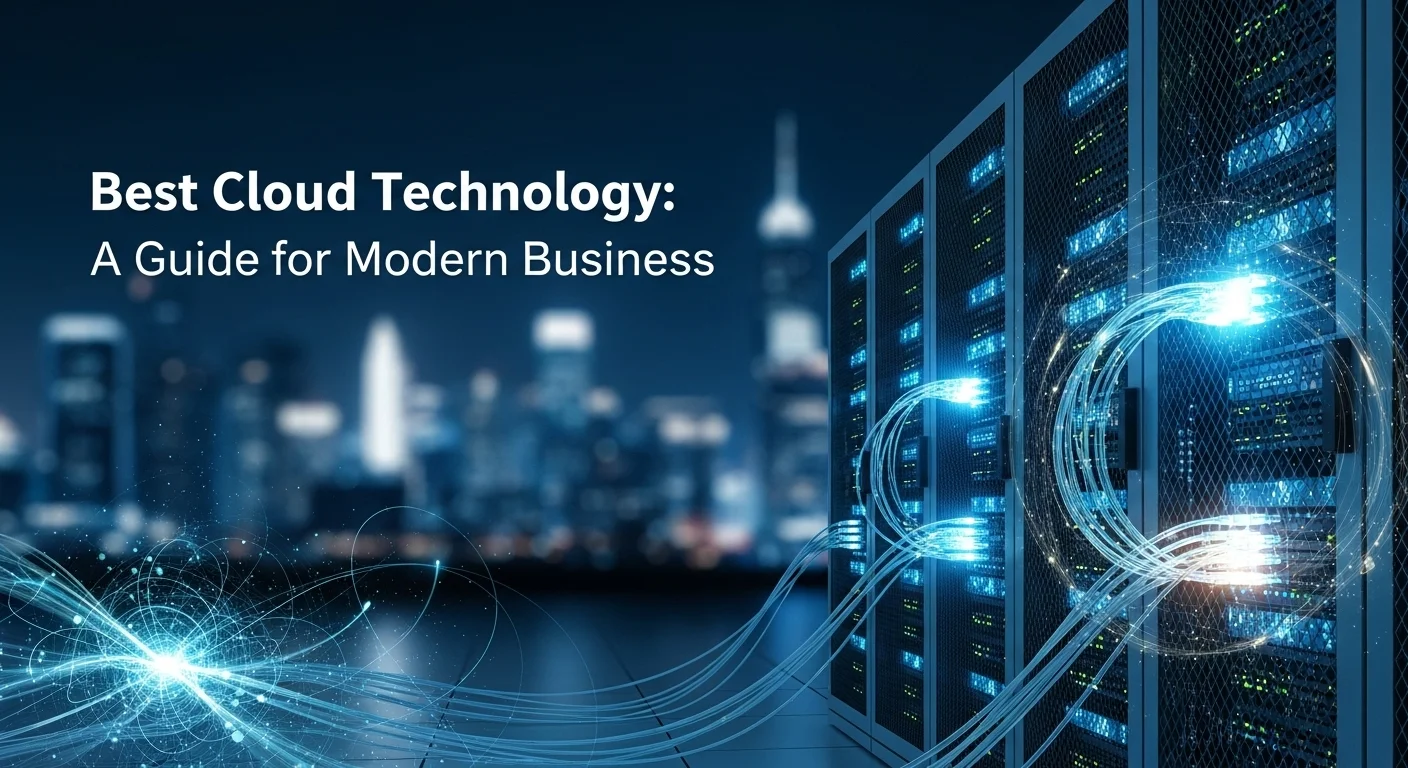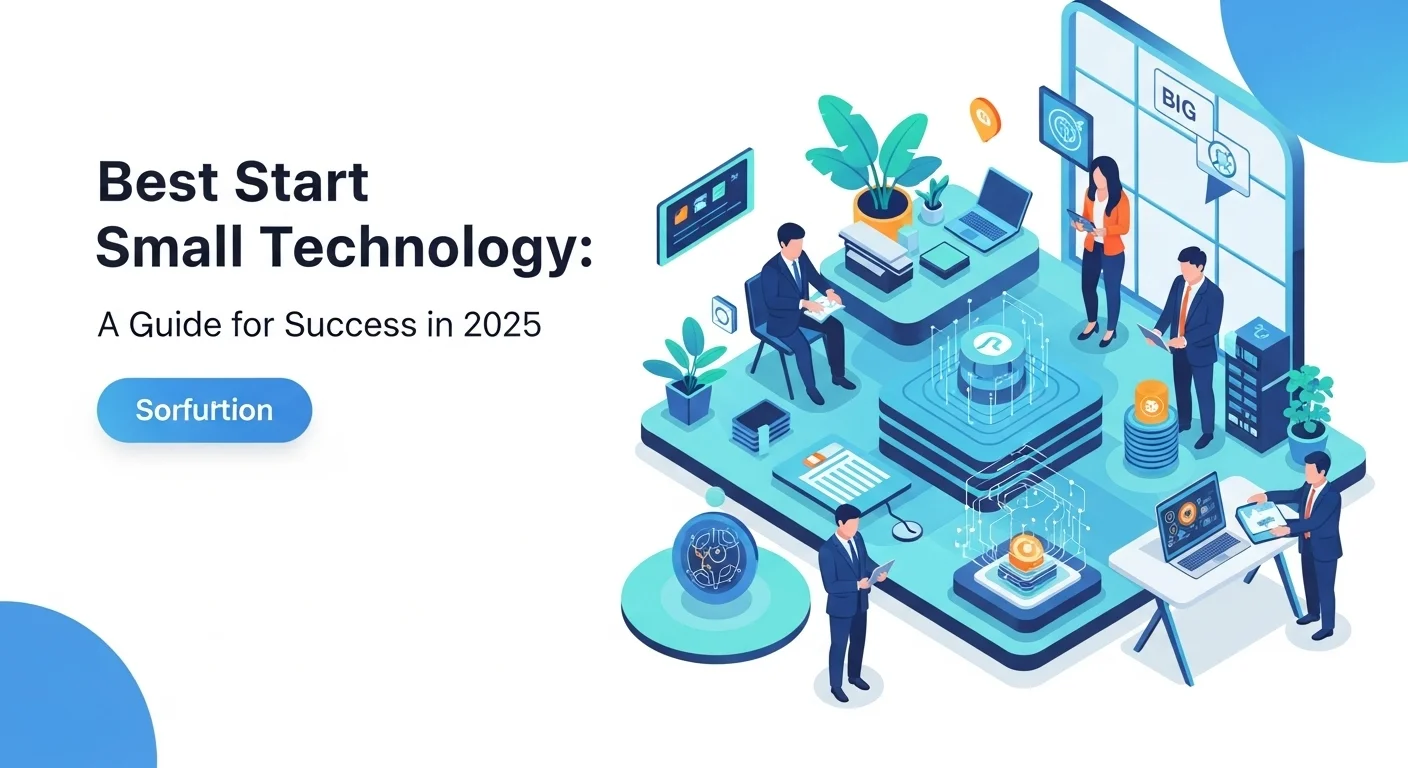Finding Your 'Best' Cloud: A Practical Guide for Today's Businesses

Executive Summary
Navigating the world of cloud computing can feel overwhelming. In my years as a strategist, I've seen businesses transform by finding the *right* cloud solution for their unique needs. This guide is my way of breaking it all down for you. We'll cut through the jargon, compare the top players like AWS and Azure, and explore practical topics like data storage and security. My goal is to give you the confidence to choose a cloud setup that not only works but gives you a real competitive edge.
Table of Contents
Table of Contents
- What Is the 'Best' Cloud and Why Does It Matter?
- Understanding the Core Cloud Service Models
- The Real-World Impact of Cloud on Business
- Choosing Your Data Storage and Private Cloud Path
- Comparing the Cloud Giants: AWS vs. Azure vs. GCP
- A Step-by-Step Method for Choosing Your Cloud Solution
- Mastering Cloud Costs (FinOps)
- Strengthening Your Cloud Security
- Driving Innovation with Advanced Cloud Tools
What Is the 'Best' Cloud and Why Does It Matter?
Whenever someone asks me, 'What's the *best* cloud?', my answer is always the same: it depends. There’s no single ‘best’ for everyone. The 'best' cloud for your business is the unique mix of services that strikes the perfect balance between performance, cost, and security for what you need to accomplish. At its core, cloud computing is simply delivering computing services—servers, storage, software, and even intelligence—over the internet. For years, I've seen this technology become the engine of modern business, allowing companies to become more nimble, innovative, and resilient. Getting this choice right affects everything from your budget to your ability to use exciting tech like AI. The shift is happening fast; by 2025, it's expected that over 95% of new digital projects will be built directly in the cloud, a huge leap from just 30% in 2021.
Understanding the Core Cloud Service Models
To find your perfect cloud setup, you first need to understand the main flavors it comes in. These models just define how much control you have versus how much is managed for you.
- Infrastructure as a Service (IaaS): Think of this as leasing the essential hardware. You rent servers, storage, and networking from a provider like Amazon Web Services (AWS) and pay as you go. You get maximum flexibility and control, just without the headache and cost of buying and maintaining physical machines. I've seen countless startups get off the ground with IaaS because it gives them complete control without a massive upfront investment.
- Platform as a Service (PaaS): This model goes a step further. It gives you the infrastructure *and* a platform with tools to build and run your own applications. You don't have to worry about the underlying operating systems or databases. For development teams, PaaS is a game-changer. I’ve seen teams using Microsoft Azure's PaaS offerings to create and launch new software in a fraction of the time it would normally take.
- Software as a Service (SaaS): You're already using this every day. SaaS is software you access over the internet on a subscription, like Gmail, Salesforce, or Microsoft 365. The provider handles everything—the software, the updates, the security. For most businesses, using SaaS for common needs is a no-brainer because of its simplicity and predictable cost.
The right path for you might be one of these, or more often, a combination. A small business might rely entirely on SaaS, while a larger company might use IaaS to migrate its complex systems and PaaS for new development projects.
The Real-World Impact of Cloud on Business
Moving to the cloud isn't just a tech trend; it's a fundamental business strategy. The global spending numbers are astronomical because the benefits are so tangible.
- Scalability and Flexibility: This is the cloud's classic superpower. Imagine your website traffic suddenly tripling during a promotion. With the cloud, your system can automatically scale up to handle the load and then scale back down when things quiet down. You only pay for what you use, which is a massive advantage over owning hardware that sits idle most of the time.
- Cost Efficiency: The cloud shifts your spending from buying expensive equipment (Capital Expenditure) to a more manageable, subscription-like model (Operational Expenditure). It’s not always cheaper, though. I've seen that cost management has become a huge focus for IT leaders, so it requires smart planning to be truly efficient.
- Enhanced Security: People used to worry about cloud security, but today, top providers like AWS, Azure, and Google have security teams and budgets that dwarf what most individual companies can afford. They offer sophisticated tools and adhere to global standards like GDPR, making the cloud a very secure option when configured correctly.
- Innovation and Agility: This is where it gets exciting. The cloud gives you access to powerful technologies like AI and machine learning that were once reserved for tech giants. I’ve seen small e-commerce shops use AI-powered recommendation engines to compete with Amazon. The cloud levels the playing field for innovation.
- Disaster Recovery and Reliability: In my experience, having a solid disaster recovery plan is non-negotiable. Cloud services make this much easier and more affordable. By storing backups in geographically separate locations, you can ensure your business stays online even if a local disaster strikes.
Choosing Your Data Storage and Private Cloud Path
Your data is invaluable, so deciding how to store it in the cloud is a critical step. The best approach isn't one-size-fits-all. You have options like object storage (great for unstructured files like videos and backups), file storage (acts like a shared network drive), and block storage (high-performance storage for databases). For daily use, services like Google Drive and Dropbox are fantastic for collaboration, but for business-critical applications, the choice depends entirely on your performance and data type needs.
While public clouds offer incredible power, sometimes a private cloud is the right answer due to strict security or compliance rules. A private cloud is an infrastructure dedicated entirely to your organization. To run it, you need powerful management software. For years, the two main players have been VMware and OpenStack. VMware is the established, enterprise-grade choice—it’s known for being incredibly stable and well-supported, though it comes with licensing costs. OpenStack is the open-source alternative; it's powerful, flexible, and free of licensing fees, but it demands significant technical expertise to run. I've seen companies succeed with both, and the choice often boils down to this: Do you prefer the reliability of a ready-made solution or the flexibility of building your own? Increasingly, businesses are choosing a hybrid approach, mixing public and private clouds to get the best of both, with nearly 90% of enterprises now having a multi-cloud or hybrid strategy in place.

A Head-to-Head Comparison of the Top Cloud Service Providers
Choosing a cloud solution is one of the most important tech decisions you'll make. It affects your budget, your speed, your security, and your ability to innovate. Let's break down the major players to help you navigate this decision.
Comparing the Cloud Giants: AWS vs. Azure vs. GCP
The cloud market is dominated by three 'hyperscalers': Amazon Web Services (AWS), Microsoft Azure, and Google Cloud Platform (GCP). I've worked with all three extensively, and while they offer similar services, they each have a distinct personality and excel in different areas.
1. Amazon Web Services (AWS)
- The Lowdown: AWS is the veteran and market leader. They basically invented the modern cloud market back in 2006, and that head start shows.
- My Take on Their Strengths: Their biggest advantage is the sheer breadth and maturity of their services. They have a tool for almost anything you can imagine, from basic computing to satellite communication. It's an incredibly reliable and comprehensive platform. Their massive global presence also means you can run your applications close to your users anywhere in the world.
- Who Should Use It: I often recommend AWS to companies that need the widest array of tools and a proven, battle-tested platform. It’s a go-to for scalable web applications and businesses that want maximum flexibility.
2. Microsoft Azure
- The Lowdown: Azure is the strong number two, and their growth has been explosive, largely because they've leveraged Microsoft's existing dominance in the enterprise world.
- My Take on Their Strengths: Azure's killer feature is its seamless integration with other Microsoft products. If your company runs on Windows Server, Office 365, and Active Directory, choosing Azure feels like a natural extension. I've found their hybrid cloud solutions, like Azure Arc, are best-in-class for managing both on-premise servers and cloud resources together.
- Who Should Use It: It's an almost unbeatable choice for large businesses already deep in the Microsoft ecosystem. I also point clients in regulated industries toward Azure due to their strong focus on enterprise-grade compliance and support.
3. Google Cloud Platform (GCP)
- The Lowdown: GCP is the fast-growing third-placer, making its name by excelling in cutting-edge, data-focused technologies.
- My Take on Their Strengths: Google's DNA is all about data, and that's where GCP shines. Their expertise in data analytics, AI, machine learning, and especially Kubernetes (which they invented) is second to none. I've seen developers fall in love with GCP for its clean interfaces and developer-friendly, often more competitive, pricing.
- Who Should Use It: I recommend GCP for companies whose business revolves around data. If you're building AI/ML applications, doing large-scale data analysis, or developing cloud-native apps with containers, GCP is a powerhouse.
A Step-by-Step Method for Choosing Your Cloud Solution
Picking the right cloud partner is a process. Jumping in without a plan can lead to wasted money and security headaches. Here's the methodical approach I walk my clients through:
- Assess Your Actual Needs: Before you even look at a provider, look inward. What do your applications need? What kind of data are you storing? What are your traffic patterns? Be honest about your growth plans so you choose a solution that can grow with you.
- Put Security and Compliance First: Security is not an afterthought. Evaluate each provider's security tools, from firewalls to data encryption. Crucially, make sure they comply with any regulations that govern your industry, like HIPAA or GDPR. Look for certifications like ISO 27001; they're proof of a provider's commitment to security.
- Read the Fine Print (SLAs): The Service Level Agreement (SLA) is the provider's promise of uptime. Understand what they guarantee and what happens if they fail to deliver. Reliability is key, so look at their track record.
- Compare the True Cost: Cloud pricing is notoriously tricky. Don't just compare the cost of a single server. You need to calculate the Total Cost of Ownership (TCO), including data transfer fees, storage, and support. Take advantage of different pricing models like Pay-As-You-Go for unpredictability, and Reserved Instances for stable workloads to get huge discounts.
- Plan Your Exit Strategy: It sounds counterintuitive, but think about how you would leave a provider before you even sign up. Relying too heavily on one provider's proprietary tools can lead to 'vendor lock-in,' making it hard to move later. I always advise using open-source technologies like Kubernetes where possible to keep your options open.
Finding the Right Home for Your Data
Your cloud data storage strategy shouldn't be a one-size-fits-all bucket. A smart approach is to tier your data based on how often you need to access it.
- Hot Storage: For data you need instantly, like the files for your live website or active databases. This is the highest-performing but also the most expensive tier.
- Cool Storage: For data you access less often, like recent backups or analytics data. You get lower storage costs in exchange for slightly higher fees when you access the data.
- Archive/Cold Storage: For long-term data you rarely, if ever, touch, like compliance archives. This is incredibly cheap to store, but retrieving the data can take minutes or even hours.
For collaboration, tools like Dropbox for Business and Microsoft OneDrive are excellent because they integrate so well with the way people already work.
Selecting the Best Private Cloud Software
If you've decided a private cloud is the way to go, your choice of management software is critical. My experience primarily comes down to two major options:
- VMware: This is the long-standing leader in the enterprise world. It’s an integrated suite of tools that is incredibly stable, powerful, and well-supported. It's the 'it just works' solution for businesses that prioritize reliability and have the budget for licenses.
- OpenStack: This is the powerful, open-source alternative. It’s modular, incredibly flexible, and has no licensing fees. The trade-off? It's complex. You need serious in-house technical skill to get it running and maintain it. It's the best fit for tech-savvy organizations that want to avoid vendor lock-in and build a completely custom environment.
Ultimately, building the right cloud solution is about careful planning. By methodically comparing providers, understanding your own needs, and choosing the right tools, you can create a powerful technology foundation that will drive your business forward for years to come.

Tips and Strategies to Get the Most Out of Your Cloud Experience
Once you've picked a provider and moved your first applications to the cloud, the journey has just begun. I've learned over the years that the real magic happens through ongoing optimization and smart strategy. Here are some practical tips to make sure you're getting the most from your cloud investment, from managing costs to boosting security and driving real innovation.
Mastering Cloud Costs (FinOps)
I've seen it happen too many times: a team gets excited about the cloud's power, and a month later, they're shocked by the bill. Adopting a mindset of Financial Operations, or FinOps, is essential.
- Tag Everything: The first rule of controlling costs is knowing where the money is going. Use 'tags' (simple labels) to assign every cloud resource to a specific project, department, or team. This creates instant accountability.
- Stop Over-Provisioning: It's easy to spin up a powerful server, but most of the time, they are oversized. Regularly check your usage. If a server is only using 10% of its power, shrink it! Providers have tools that give you these recommendations automatically. It's one of the easiest ways to save money.
- Commit for Big Savings: If you have workloads that run 24/7, like a main database, paying by the hour is wasteful. Commit to a one- or three-year plan for those resources. Providers will give you discounts of up to 70% or more. It's a no-brainer for predictable usage.
- Use Spare Capacity for Non-Critical Tasks: For tasks like data processing or testing, you can bid on a provider's unused capacity using 'Spot Instances'. The savings are massive (up to 90% off), but the catch is your work can be interrupted. It’s perfect for tasks that can be paused and restarted.
- Turn Off the Lights: Your development and test environments don't need to run on nights and weekends. Set up simple automated scripts to shut them down when your team goes home. This simple habit can cut your non-production costs in half.
Strengthening Your Cloud Security
Security in the cloud is a partnership. The provider secures the global infrastructure, but you are responsible for securing what you put inside it.
- Adopt a 'Trust No One' Security Mindset: The old idea of a secure network perimeter is dead. A 'zero-trust' approach means you verify every single request for access, no matter where it comes from. This starts with strict identity policies, ensuring users and services have only the minimum permissions they need to do their jobs.
- Automate Your Compliance Checks: Don't try to manually check if you're compliant with rules like GDPR or HIPAA. Use the cloud's own tools to constantly scan your setup for misconfigurations or policy violations. They can even fix some issues automatically and generate reports for audits.
- Encrypt Everything Sensitive: This is non-negotiable. Encrypt your data when it's stored on a disk (at rest) and as it moves across the network (in transit). The major cloud providers give you powerful tools to manage your own encryption keys securely.
- Scan for Vulnerabilities Constantly: Don't wait for an attack. Integrate security scanning directly into your development process. This way, you can find and fix security flaws in your code before they ever make it to a live environment.
Driving Innovation with Advanced Cloud Tools
The cloud isn't just a cheaper place to run servers; it's an innovation engine.
- Democratize AI and Machine Learning: You no longer need a team of data scientists to use AI. I've seen businesses use pre-trained AI services for everything from image recognition to language translation. Platforms like Amazon SageMaker or Google's Vertex AI make it possible to build, train, and deploy your own custom machine learning models.
- Go Serverless: This is one of my favorite cloud advancements. With 'serverless' computing, you can run your code without thinking about servers at all. You upload a function, and the cloud runs it and scales it for you. You pay only for the split seconds your code is running. It lets your developers focus purely on creating value, not managing infrastructure.
- Analyze Data at Massive Scale: The cloud gives you the power to analyze enormous datasets to find hidden insights. Tools like Google BigQuery or Amazon Redshift can run complex queries on petabytes of data in seconds, a task that would have been impossible for most companies just a decade ago.
Picking the Right Tools for the Job
To manage a modern cloud environment effectively, you need the right toolset.
- Define Infrastructure as Code (IaC): Manually clicking around a web console to set up your environment is slow and error-prone. Use tools like Terraform or AWS CloudFormation to define your entire infrastructure in code. This makes your deployments repeatable, predictable, and version-controlled.
- Invest in Observability: To keep things running smoothly, you need to see what's happening inside your applications. While providers have native monitoring tools, third-party platforms like Datadog or New Relic often provide a more complete picture by combining logs, metrics, and traces in one place.
- Manage Your Private Cloud Wisely: If you're running a private cloud on VMware, its vRealize Suite offers powerful management and automation. If you chose the open-source path with OpenStack, you have incredible flexibility to integrate best-of-breed tools for monitoring and automation, but it requires more hands-on effort to stitch them together.
In the end, getting the most from the cloud is a continuous cycle of learning and improving. By controlling costs, prioritizing security, leaning into innovation, and using the right tools, you can transform your cloud from a simple utility into the core driver of your business's success.
Expert Reviews & Testimonials
Sarah Johnson, Business Owner ⭐⭐⭐⭐
As a small business owner, this guide was a great starting point for understanding cloud options. It demystified the big players like AWS and Azure. I would have loved a few more case studies for non-tech businesses, but it was very helpful!
Mike Chen, IT Consultant ⭐⭐⭐⭐
Solid overview of the cloud landscape. The step-by-step guide for choosing a provider in Part 2 was particularly useful for framing discussions with my clients. A good, clear read.
Emma Davis, Tech Expert ⭐⭐⭐⭐⭐
Fantastic article! As a tech pro, I appreciated the depth in the private cloud software comparison between VMware and OpenStack. It's comprehensive without being overly technical. Definitely sharing this with my team.



